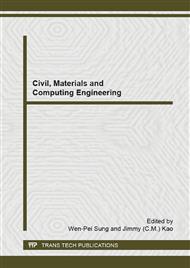p.3
p.7
p.13
p.18
p.22
p.28
p.33
p.37
A Study on Recycling of Paper Sludge and Steel Slag Based on Circular Economy
Abstract:
Steel slag, a kind ofindustrial residues, is generated in the process of steel-making. Paper sludgeis the final material which origins from the treatment of liquid waste. Allthese resulted in a serious pollution of environment, how to achieve thecoordinate development among enterprise, environment and society become apressing matter of the moment. Based on this, Circular economy becomenecessary. Based on circular economy, the two kinds of industrial wastes weremixed to manufacture useful materials through carbonation in this research. Therequired raw materials were mixed by mortar mixer at the specified mixingratio. Then the mixture was transferred to a stainless steel mould formanufacturing of rectangular composite specimens. Only in this way, It is toshift from the paper maunfacturing and ironmaking and steelmaking industrywhich is over-consumption of energy and natural resources and very seriousenvironmental pollution to the industry which is less pollution and thedevelopment of multi-part cycle.
Info:
Periodical:
Pages:
13-17
Citation:
Online since:
December 2014
Authors:
Keywords:
Price:
Сopyright:
© 2015 Trans Tech Publications Ltd. All Rights Reserved
Share:
Citation:


